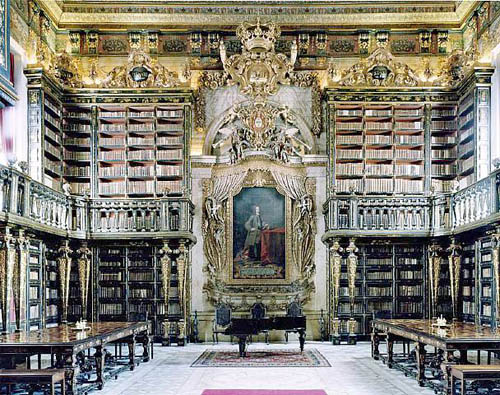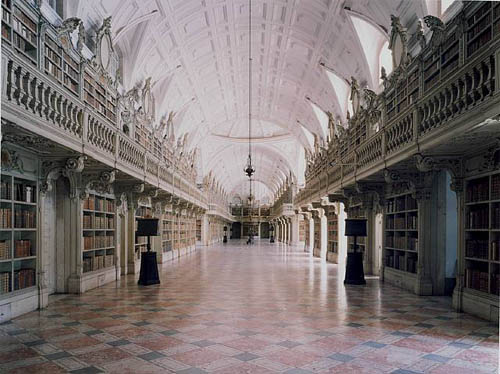The photographs of libraries in “Portugal,” the current exhibition of Candida Höfer at Sonnabend, show libraries as venerable places where precious objects are stored.

The large format that characterizes Höfer’s photographs of public places, the absence of people, and the angle from which she composes them, invite the viewer “to enter” the rooms and observe. Photography is a silent medium and in Höfer’s libraries this is magnified, creating that feeling of “temple of learning” with which libraries have often been identified. On the other hand, the meticulous attention to detail, hand-painted porcelain markers, ornately carved bookcases, murals, stained glass windows, gilt moldings, and precious tomes are an eloquent representation of libraries as palaces of learning for the privileged. In spite of that, and ever since libraries became public spaces, anyone, in theory, has access to books and the concept of gain or monetary value rarely enters the user’s mind.

Libraries are a book lover’s paradise, a physical compilation of human knowledge in all its labyrinthine intricacy. With digitization, libraries gain storage capacity and readers gain accessibility, but they lose both silence and awe. Even though in the digital context, the basic concept of the library as a place for the preservation of memory remains, for many “enlightened” readers the realization that human memory and knowledge are handled by for-profit enterprises such as Google, produces a feeling of merchants in the temple, a sense that the public interest has fallen, one more time, into private hands.
As we well know, the truly interesting development in the shift from print to digital is the networked environment and its effects on reading and writing. If, as Umberto Eco says, books “are machines that provoke further thoughts” then the born-digital book is a step toward the open text, and the “library” that eventually will hold it, a bird of different feather.
if:book
A Project of the Institute for the Future of the Book

“As we well know, the truly interesting development in the shift from print to digital is the networked environment and its effects on reading and writing. “
All print is now digital so its probably less confusing to say something like “shift from print to screen”. Myself, I feel these dicotomies hard linking transmission to paper or network are too simple and obscure the ecology of transmission modes.
I was wondering… are these two shots HDR?